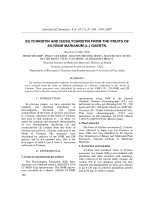Preparing fruits
Bạn đang xem bản rút gọn của tài liệu. Xem và tải ngay bản đầy đủ của tài liệu tại đây (531.2 KB, 28 trang )
Preparing Fruits
Lesson Objectives
• Improve the quality of
fruits served.
• Improved the variety of
fruits served.
• Improve the appeal of
fruits served.
Preparing Fruits: Important Terms
• Culinary*
• Culinary Technique*
• Ethylene Gas
• Just-In-Time Preparation*
• Mise en Place (Meez-un-plahss)*
• Nutrients*
• Seasonal Produce
*Discussed in a prior lesson
Mise en place
• Cutting boards
• Slicing equipment
• Knives
• Produce sink
Guidelines for Washing Fruit
• Follow state or local health department
requirements.
• Wash hands using the proper procedure prior
to handling fruit.
• Wash, rinse, sanitize, and air-dry all foodcontact surfaces.
Washing Fruit (cont.)
• Wash all raw fruits thoroughly under cold
running water before combining with other
ingredients, including:
– unpeeled fresh fruits served whole or cut.
– fruits that are peeled and cut.
• Packaged fruits labeled as being previously
washed and ready-to-eat are not required to
be washed.
Washing Fruit (cont.)
• Scrub the surface of film fruits using a clean
and sanitized brush designated for this
purpose.
• Remove any damaged or bruised areas.
• Label, date, and refrigerate fresh-cut items.
Using, Handling, and Storing Fruit
• Review Using, Handling, and Storing Fruits chart in
Participant’s Workbook.
• Produce Safety fact sheets.
• Available at NFSMI.org
• Best Practices for Handling Fresh Produce in Schools
fact sheet.
• Available at NFSMI.org
Ethylene Gas
• Ethylene Producing Produce
• Ethylene Sensitive Produce
• What are examples of each?
Menu Planning Tips
• Offer more fresh fruits daily.
• Offer cut-up fresh, frozen, canned, or dried
fruit as a topping for yogurt.
• Offer fruit rich in potassium (bananas).
Menu Planning Tips (cont.)
• Offer fruit as snacks.
• Offer fresh fruits using a variety of
presentations.
Demonstration
• A selection of fresh fruit.
Purchasing Healthy School Foods
•Purchase fruits canned in light syrup or natural fruit juices instead of
heavy syrup.
•Purchase fresh fruits, when feasible, to substitute for canned fruits.
•Look to local farmers as an alternative for purchasing fresh produce.
www.farmtoschool.org for more information
Demonstration
Various purchasing forms of a fruit:
• Fresh
• Frozen
• Dried
• Canned
• Juiced
Activity
Review labels of canned fruit in heavy syrup,
light syrup, or natural juice.
Healthy Fruit Facts
• Provide important vitamins, minerals, and
other nutrients.
• Excellent source of vitamin C.
• Low in fat.
• Low in sodium.
Basic Principles of Preparing Fruits
• Use fresh fruits at their peak of ripeness.
• Wash fresh fruits under cool, running water
before they are peeled or stemmed.
• Cut fresh fruits in to the largest pieces that are
acceptable for serving to children.
Basic Principles of Preparing Fruits (cont.)
• Prepare fruit dishes so they have an appealing
appearance.
• Prevent oxidation or browning of fruits by using an
acid, such as lemon or pineapple juice immediately
after cutting.
• Store and serve at the right temperature.
Activity
• Demonstrate apple dipped in lemon juice and
apple that was not dipped.
• Discuss the Flavor Enhancement Chart in
participant’s workbook.
• Taste test herbs and spices.
Video: Preparing Fruits
Fruit Salads and Side Dishes
• Select the appropriate
form for the recipe.
• Prepare in serving size
pieces and keep chilled
and covered until
service.
• Prepare fruit dishes so
that they have the
appropriate texture.
Video: Preparing Fruit Side Dishes
Baked Fruits
• Select a recipe for the baked fruit item.
• Use the right form of the fruit for the recipe.
• Prepare the baked fruit recipe.
Video: Preparing Baked Fruit
Fruit Sauces
• Select a recipe for the fruit sauce.
• Use the right form of the fruit for the recipe;
adjust sugar as needed.
• Prepare the fruit sauce recipe.









